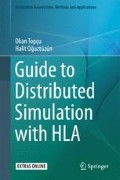Abstract
It is a known observation that federate applications involve large amounts of boilerplate code. Code generation is an effective technique that helps with rapid prototyping of a federation. Code generation can be seen as a model-to-text transformation, which takes a federation architecture as the source model and transforms it to an executable code for a target environment. In this chapter, we show you how code generation for each federate application in a federation architecture can be done using SimGe. The target environment is C# and .NET with RACoN platform as the abstraction layer for the RTI.
Access this chapter
Tax calculation will be finalised at checkout
Purchases are for personal use only
Notes
- 1.
The use of “class” word can be confusing in this chapter. When we use “class” in the text, we need to make sure to distinct that it is used either in the sense of programming language concept or in the sense of HLA terminology. From now on (throughout the rest of the chapters), we reserve the “class” term to refer a class in object-oriented programming, a code template for creating objects, for instance, a federate class for the generated code. Nevertheless, to make the distinction, we use “HLA class,” when we are referring to an object class or to an interaction class of an object model.
References
dofactory. (2016). C# coding standards and naming conventions. [Online] Available at: http://www.dofactory.com/reference/csharp-coding-standards.aspx. Accessed November 12, 2016.
Microsoft. (2017). Microsoft visual studio. [Online] Available at: https://www.visualstudio.com/. Accessed April 16, 2017.
Microsoft .NET. (2017). MS .NET. [Online] Available at: http://www.microsoft.com/net. Accessed April 16, 2017.
Author information
Authors and Affiliations
Corresponding author
Rights and permissions
Copyright information
© 2017 Springer International Publishing AG
About this chapter
Cite this chapter
Topçu, O., Oğuztüzün, H. (2017). Code Generation. In: Guide to Distributed Simulation with HLA. Simulation Foundations, Methods and Applications. Springer, Cham. https://doi.org/10.1007/978-3-319-61267-6_6
Download citation
DOI: https://doi.org/10.1007/978-3-319-61267-6_6
Published:
Publisher Name: Springer, Cham
Print ISBN: 978-3-319-61266-9
Online ISBN: 978-3-319-61267-6
eBook Packages: Computer ScienceComputer Science (R0)

